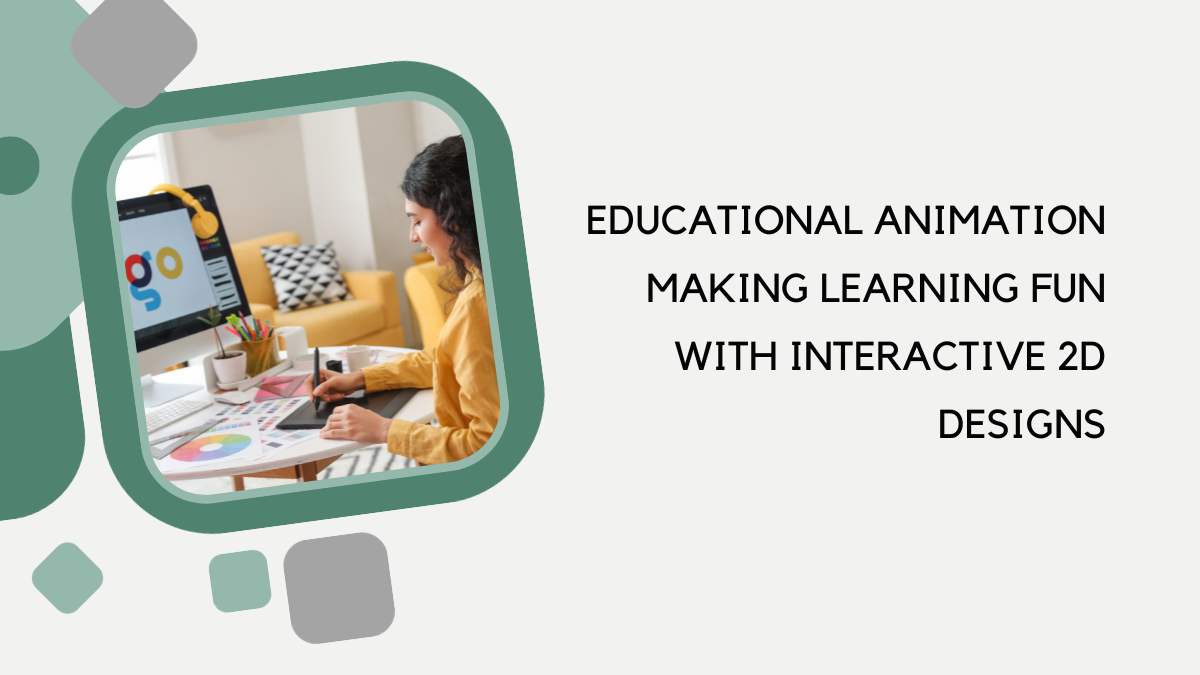
Educational Animation Making Learning Fun with Interactive 2D Designs
Are you tired of the same old textbook-based learning methods that put you to sleep faster than a lullaby? Well, get ready to wake up your brain and dive into a world where education meets entertainment! In our latest blog post, we will explore the fascinating realm of educational animation and how it can revolutionize our learning.
From interactive 2D designs that bring complex concepts to life to captivating visuals that make studying an absolute blast – this is one journey you won’t want to miss. So buckle up and prepare for an exhilarating adventure where fun and knowledge collide in perfect harmony!
The rise of interactive 2D designs in education
Interactive 2D designs have revolutionized the education industry, making learning more engaging and enjoyable for students. These designs incorporate interactive elements such as animations, games, and quizzes into traditional 2D visuals, creating a dynamic learning experience.
One of the main reasons for the rise of interactive 2D designs in education is their ability to cater to different learning styles. Visual learners can benefit from the vibrant and colorful animations, while kinesthetic learners can engage with interactive games that require physical movement. This allows students to absorb information in a way that suits them best, leading to better understanding and retention of knowledge.
Another advantage of using interactive 2D designs in education is their ability to bring complex concepts to life. Abstract or difficult topics can be simplified and relatable through creative animations and interactive elements.
For example, a physics lesson on gravity can be transformed into an entertaining game where students control the trajectory of falling objects.
How animation can engage and motivate learners
Animation has been used in various educational settings to make learning more engaging and interactive for learners. Energy use in education has become increasingly popular due to its ability to capture students’ attention and motivate them to learn.
In this section, we will explore how animation can engage and motivate learners.
- Visual Appeal – One of the main reasons why animation is so effective in engaging learners is because of its visual appeal. Unlike traditional teaching methods that rely heavily on text-based materials, energy utilizes colorful images, dynamic movements, and sound effects to convey information. These visual elements are not only aesthetically pleasing but also help in breaking down complex concepts into more straightforward, more understandable visuals that can captivate the audience’s attention.
- Interactive Learning – Another way animation can engage learners is through interactive learning experiences. With advancements in technology, animated videos now have the capability of being interactive by including clickable elements or quizzes within the video itself. This allows students to actively participate and engage with the material rather than just passively consuming it. This hands-on approach not only makes learning more enjoyable but also helps students retain information better.
- Personalization – Animated videos have the advantage of being customizable, making it easier for educators to personalize content according to their students’ needs and interests. By tailoring animations specifically for a particular group or individual, teachers can create a more relatable learning experience for their students. This personal touch makes students feel like they are being directly addressed, increasing their motivation to learn.
Tips for creating effective educational animations
Creating educational animations is a great way to make learning more engaging and interactive for students. It allows them to visualize complex concepts and ideas, making it easier for them to understand and retain information.
However, creating effective educational animations requires skill, planning, and attention to detail. Alternatively, you can hire a creative video animation company to do this work for you. In this section, we will discuss some tips for creating successful educational animations that will enhance the learning experience of your audience.
- Understand Your Audience
The first step in creating any educational content is understanding your audience. This is especially crucial when it comes to animation, as you need to tailor your visuals and language according to the age group or level of education of your target audience.
For younger children, using bright colors, simple illustrations, and fun characters can be more effective than older students, who may respond better to a more sophisticated design.
- Keep It Simple
One common mistake when creating educational animations is cramming too much information into one video. Remember that the purpose of energy is to simplify complex ideas and make them more accessible for students to grasp. Therefore, it’s essential to keep your points simple and focus clearly on the central concept or idea you are trying to convey.
The role of technology in the future of education through animation
Technology has always been a driving force in shaping the future of education, and this is especially true in the realm of spirit. With technological advancements, educational content can now be brought to life through engaging and interactive 3D designs. This opens up a new world of possibilities for educators, students, and content creators alike.
One of the most significant advantages of using animation in education is its ability to make learning fun and engaging. Traditional forms of teaching often involve static images or texts that can be dry and uninteresting for students.
However, with animation, complex concepts can be broken down into simple visuals that are easier to understand and retain. By incorporating colorful characters, dynamic movements, and captivating storylines, educational animations can capture students’ attention and keep them engaged throughout the lesson.
Challenges and limitations of using animation in education
Animation has become an increasingly popular tool in education due to its ability to engage and captivate students, making learning more fun and interactive. However, like any other technology or teaching method, it has challenges and limitations.
- Technical Limitations – One of the main challenges of using animation in education is the technical aspect. Creating high-quality and effective animations requires specialized skills and software that may not be readily available or affordable for educators. This can limit energy use only to specific subjects or topics deemed necessary enough to invest time and resources into creating animations.
Moreover, technological advancements constantly change the animation landscape, making it challenging for educators to keep up with the latest tools and techniques. This can result in outdated or less engaging animations that fail to capture students’ attention.
- Time-Consuming – Another challenge of using animations in education is that they can be time-consuming for teachers and students. Creating a well-crafted animated lesson takes time, effort, planning, and resources. Additionally, incorporating animations into lesson plans means teachers must spend extra time learning to use new software or tools effectively.




